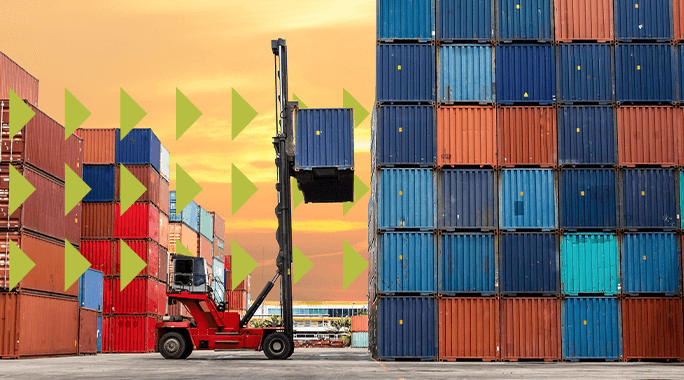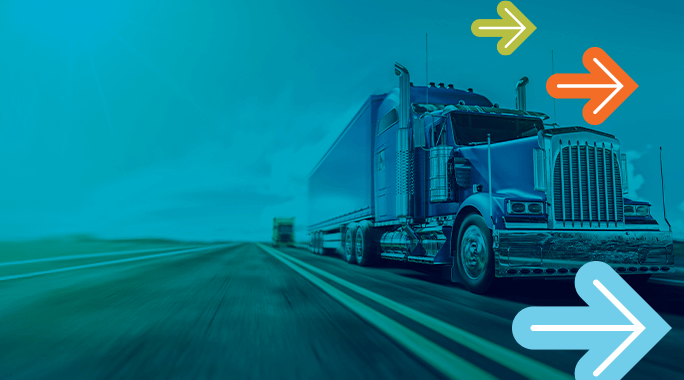BLOG POST
Logistics Simplified: Freight Shipping Terms Explained

Reading Time: 12 minutes
Every industry develops its own language, and the freight industry is no exception. Over time, shippers, carriers, brokers and logistics providers have built a system of freight shipping terms that make communication faster and more precise. While these logistics terms streamline operations for industry insiders, they can be confusing for some shippers that don't know each and every term.
The good news: you don't have to be an expert to manage shipping successfully. By learning the most common freight terms, you'll better understand modes, invoices, service options and more — helping you avoid unnecessary freight delivery fees and unexpected freight charges. This glossary highlights the freight definitions, and essential freight types you'll encounter, giving you a clear reference to simplify shipping and strengthen your decisions.
Freight Terms & Industry Lingo
As you work with carriers, third-party logistics (3PL) providers or freight brokers, you'll see specialized terms used in service guides, contracts, invoices and day-to-day communication. Some are straightforward, while others are less familiar but just as important to understand. Below, you'll find definitions for many of the most common terms used in the freight industry, along with explanations to help you apply them to your shipping needs.
Accessorial Fee: Any additional charge that applies for services outside standard pickup and delivery. Common examples include liftgate service, inside delivery, reconsignment, storage and driver assistance. These extra charges, often called freight accessorial charges, can significantly increase total freight charges if they're not anticipated in advance.
Bill of Lading (BOL): A legal document that functions as both a receipt for goods and a contract between shipper and carrier. A BOL includes critical details such as the shipper and consignee contact information, delivery instructions, shipment dimensions, weight and freight classification. A correctly completed BOL is essential for avoiding reclassification, billing disputes or delivery delays. Learn more about correctly filling out your BOL.
Blind Shipment: A shipment in which the identity of the shipper, consignee or both is intentionally concealed from one another. Blind shipping is usually arranged by a third party and is designed to prevent direct business dealings between manufacturers, distributors and end customers. Learn more about blind shipments.
Carrier Limits of Liability: The maximum amount a carrier is responsible for if freight is lost or damaged in transit. This is not the same as freight insurance and liability only applies if the carrier is proven negligent. Understanding these limits is critical for high-value shipments, where liability coverage may not provide adequate protection. Learn more about the differences between shipment insurance and carrier liability.
Consignee: The individual or business receiving a shipment. The consignee is financially responsible for accepting delivery of the goods. While the consignee is typically the same as the receiver, that is not always the case.
Dimensional (DIM) Weight: A pricing method that accounts for how much space freight occupies relative to its actual weight. DIM weight is calculated based on the length, width and height of your shipment. Carriers charge based on whichever is greater — the actual weight or the DIM weight. Learn more about how size and weight affect shipping costs.
Dry Van: An enclosed trailer, usually up to 53 feet long, that protects shipments from outside weather and road conditions. Dry vans are the most common trailer type in both LTL freight and TL freight, but they are not temperature-controlled.
Expedited Shipping: A shipping service that delivers goods faster than standard transit times. Depending on the carrier, expedited freight may move by ground or air, with delivery times ranging from the same day to within three days. Expedited service is often chosen for urgent or time-sensitive shipments. Check out our Guide To Expedited Freight Modes.
Flatbed: An open-deck trailer, typically 48 to 53 feet long, used for freight that cannot fit inside an enclosed trailer. Flatbeds are commonly used for oversized machinery, construction materials and other irregularly shaped cargo.
Freight Classification: Freight classification (or freight class) is a standardized method of classifying commodities being shipped based on the content's density, stowability, handling and liability. There are 18 possible freight classes, ranging from Class 50 (the least expensive) to Class 500 (the most expensive). The higher the class, the higher the rate for every hundred pounds shipped. As of July 2025, NMFTA (the freight class governing body) has introduced updated density subclasses and consolidated commodity codes to create a more precise classification system, though the core 50–500 scale remains. Get answers to questions about the freight class changes in 2025.
In-Bond Freight: An international shipment moving through a country without clearing customs immediately upon arrival. Instead, the goods are processed at an inland customs facility or another designated location. In-bond shipments are often used to defer duty payments or consolidate international cargo before final clearance.
National Motor Freight Classification (NMFC): The official system used to categorize freight shipments by commodity. Each item has an NMFC code and is assigned a class, which determines how it is rated and billed in LTL freight.
Heavy Haul: Shipments that exceed standard legal weight limits. Federal guidelines define heavy haul as any load weighing 80,000 pounds or more. These shipments require specialized trailers, equipment, permits and routing. Heavy haul shipments are subject to strict federal and state regulations.
Layover: A delay that forces a driver to wait until the following day to pick up or deliver a shipment. Because a layover prevents the driver from making additional deliveries, carriers apply a layover fee to recover lost productivity.
Liftgate: A hydraulic or electric platform mounted to the back of a truck that allows freight to be raised or lowered during loading and unloading. Liftgate service is necessary when a facility lacks a dock or forklift and typically incurs an accessorial fee.
Line-Haul: The long-distance transportation of goods between two major cities or ports, usually by truck.
Lumper: A third-party worker, often hired at a warehouse or distribution center, who assists with loading or unloading freight. Lumper services can include pallet breakdown, sorting or other labor-intensive tasks. Fees for lumper services are usually charged back to the shipper as additional freight fees.
Minimum Charge: The lowest rate a carrier will accept for handling a shipment, regardless of discounts. This ensures the carrier covers baseline costs.
Over-dimensional Freight: Shipments that exceed standard legal size limits, such as width, length or height. Over-dimensional freight requires permits, specialized trailers and often escort vehicles.
Oversized Freight: Loads that surpass legal size dimensions, typically more than 8.5 feet wide, 13.5 feet tall or 53 feet long. Oversized shipments often require specialized carriers and compliance with varying state regulations. Check out our Oversized Freight Checklist for Truckload Shipping.
Pallet Jack: A manually operated tool used to move palletized freight when dock equipment is unavailable. Because pallet jacks require additional labor, carriers may charge a handling fee.
Progressive (PRO) Number: A unique tracking number assigned to a shipment by the carrier. Similar to parcel tracking numbers, PRO numbers allow shipments to be monitored throughout transit.
Proof of Delivery (POD): A signed receipt confirming that a shipment has been delivered to the consignee or an authorized representative. PODs may be provided in paper or digital format. Check out our Freight Documents Guide: What You Need for Each Mode.
Protect From Freeze (PFF): A service offered during cold-weather months to prevent temperature-sensitive freight — such as liquids, chemicals or pharmaceuticals — from freezing. Carriers may use heated trailers, expedited loading or adjusted routing to protect freight. Learn more about protect from freeze.
Reconsignment/Diversion: The rerouting of a shipment to a different destination after it has already been dispatched. Because reconsignment requires additional resources, carriers apply an accessorial fee for this service.
Reefer: A temperature-controlled trailer used to transport perishable or sensitive goods such as produce, pharmaceuticals and chemicals. Reefers maintain specific temperatures to protect cargo during transit. Check out our blog on temperature-controlled freight.
Reverse Logistics: The movement of goods back to their point of origin, often for returns, recalls or restocking. Reverse logistics is a specialized service not offered by all carriers.
Sealed Divider Service: Sealed divider service allows a shipment to be first on the truck and sealed with a wall to ensure the shipment remains intact and secure in the same trailer from pick-up to delivery. Sealed trailers are designed to protect cargo in transit, providing maximum protection and security to reduce damage and loss.
Super Load: A shipment that exceeds even oversized or heavy haul dimensions. Super loads may weigh more than 200,000 pounds or exceed 16 feet in height or width. These loads require extensive planning, permitting and escort vehicles.
Supply Chain Visibility: The ability to track freight and related processes throughout the entire supply chain, from sourcing and production to final delivery. Visit our blog on How a 3PL Can Strengthen Your Supply Chain Resilience.
Tarping: The process of covering flatbed freight with heavy-duty tarps to protect it from weather and road debris. Because tarping requires additional labor, carriers charge an extra fee when this service is needed.
Tariff: A tax imposed by a government on imported or exported goods. Responsibility for paying tariffs typically falls on the importer of record, though terms may shift under specific contracts. Learn more in our blog 9 Tips To Offset the Impact of Tariffs and How a 3PL Provider Can Help.
Third-Party Logistics (3PL) Provider: A company that manages outsourced logistics functions such as freight shipping, warehousing and distribution. Also known as brokers, 3PLs give businesses access to carrier networks, technology and logistics expertise. Check out why Worldwide Express is a 3PL Partner Dedicated to Your Shipping Success.
Transportation Management System (TMS): A digital platform that allows shippers to compare rates, book shipments, track freight and manage invoices. TMS solutions improve efficiency and provide greater visibility into the shipping process. Learn about SpeedShip®, our powerful TMS platform!
White Glove Services: A premium shipping option for fragile, high-value or specialized freight. White glove delivery may include inside placement, unpacking, assembly and debris removal. Learn about the white-glove services offered by Worldwide Express.
Freight Types and Modes
Freight shipping is not a one-size-fits-all solution. Depending on your cargo's size, weight, urgency and destination, different freight types and transportation modes may be more cost-effective or reliable. Understanding the strengths and limitations of each mode helps businesses make better decisions, avoid unexpected freight fees and ensure timely deliveries. Below are the most common modes of transportation used in the freight industry today.
Air Freight: Freight transported by airplane. Air freight may move on dedicated cargo planes or in the cargo hold of commercial passenger flights. This is the fastest option for moving goods over long distances, particularly internationally. It is often used for high-value or time-sensitive shipments, such as medical supplies or replacement parts needed to prevent costly production delays. While air freight is significantly more expensive than ground or ocean shipping, its speed makes it invaluable when deadlines cannot be missed.
Cross-Border Freight: Freight shipped by truck across international borders between the United States and its neighbors, primarily Canada and Mexico. Cross-border trucking is a cornerstone of North American trade and a cost-effective alternative to air freight. Carriers, brokers and 3PLs specializing in cross-border shipments must be familiar with customs requirements and regulations for both origin and destination countries to avoid costly delays.
Drayage: The short-distance movement of freight, usually in shipping containers, from ports or rail terminals to warehouses or final destinations. Drayage often covers just a few miles but is an essential part of intermodal and multimodal shipping. Without drayage, cargo arriving at ports or rail yards would not make it to warehouses or distribution centers for further handling.
Full Truckload (FTL): Also called truckload freight or TL shipping, FTL refers to shipments that fill an entire trailer or weigh more than 20,000 pounds. In FTL shipping, one shipper's freight occupies the whole trailer, eliminating the need to share space with other shipments. Because the truck is dedicated to a single load, FTL often provides faster transit times and less handling, reducing the risk of damage. FTL is commonly used for high-volume shipments, bulk commodities or freight with tight delivery windows.
Intermodal: A method of shipping that combines multiple modes of transportation — such as truck, rail and ocean — to move freight from origin to destination. In intermodal shipping, each leg of the journey may involve a different carrier, and each requires its own bill of lading. Freight typically remains in the same container throughout the trip, reducing handling and minimizing the risk of damage. Intermodal is often chosen for long-haul domestic and international moves where cost savings outweigh the added complexity.
Less-than-Truckload (LTL): Also referred to as LTL freight or LTL shipping, this mode consolidates shipments from multiple customers into a single trailer. It is ideal for loads too large for parcel shipping but too small to require a full truckload, typically weighing between 150 and 15,000 pounds or occupying six standard pallets or fewer. LTL offers cost savings because each shipper pays only for the trailer space used, but it involves more handling and transfers, which can increase the risk of damage if freight is not packaged properly.
Multimodal: Similar to intermodal but with one important distinction: a single provider manages the entire shipment. This means one bill of lading covers the full journey, one invoice is issued and one tracking system is used. Multimodal shipping simplifies management for shippers while still leveraging multiple transportation modes. It is especially useful for complex or international shipments that require careful coordination.
Ocean Freight: The transport of goods by sea, typically in large containers on ocean vessels. Ocean freight is often the most economical way to move large, heavy or non-urgent international shipments. Although slower than air freight, it is the backbone of global trade and is indispensable for businesses shipping in bulk. Containers can be standardized (20- or 40-foot) or specialized for oversized or unusual cargo.
Partial Truckload (PTL): PTL is used when freight is too large for LTL but not large enough to justify a full truckload, often between 8,000 and 27,500 pounds or 8–18 pallets. Unlike LTL, PTL shipments typically do not require freight classification and may be transferred less frequently during transit, reducing handling and potential delays. Shippers only pay for the space their freight occupies.
Volume LTL: A specialized option within LTL services, volume LTL is used for shipments that are larger than standard LTL but smaller than PTL or FTL. This typically applies to shipments weighing more than 5,000 pounds, occupying six or more pallets or exceeding 12 linear feet of trailer space. Volume LTL shipments are priced according to an LTL carrier's rate base and require classification under NMFC rules. For shippers, this service provides a cost-effective way to move larger shipments without paying for a full truckload.
Freight Accessorial Charges and Fees
Standard transportation rates cover the cost of moving freight from one location to another, but they do not include every possible service a shipment may require. Many circumstances call for additional work, equipment or time, and carriers charge for these services separately. These additional costs are known as freight accessorial charges. For shippers, understanding these extra freight fees is essential to budgeting accurately and avoiding surprises on invoices.
Below are some of the most common accessorial terms used in the freight industry, along with explanations of why they matter for your business.
Deadhead Miles: This charge applies when a truck must travel without carrying cargo, usually on its return trip. Empty miles are inefficient for carriers, consuming fuel, time and equipment capacity without generating revenue. To offset this loss, carriers apply a fee for deadhead miles. These charges are especially common in TL freight, where an entire truck may need to return empty after completing a delivery. Check out our blog Freight Quotes: 4 Steps to Success.
Detention/Dwell Time: When a driver is kept waiting beyond the agreed-upon window for loading or unloading, a detention or dwell time fee applies. Carriers impose these fees because delays prevent drivers from completing other deliveries or meeting federally regulated hours-of-service requirements. While some contracts allow a short grace period, longer delays almost always incur charges. Learn how to prevent dwell time, keep carriers happy and become a shipper of choice.
Inside Delivery: If a driver is required to move freight beyond the truck's liftgate, dock or front door, the service is classified as inside delivery. This could involve transporting freight into a warehouse, office or even up a set of stairs. Because it requires extra time and labor, inside delivery is always billed as an additional service.
Fuel Surcharge (FSC): One of the most common accessorial charges, a fuel surcharge is added to shipments to cover fluctuations in fuel prices. The rate is typically tied to a national index and may change weekly. FSC applies broadly across both LTL shipping and TL shipping and ensures carriers can adjust for the unpredictable cost of fuel. Check out our Complete Guide To Freight Fuel Surcharges.
Limited Access Pickup/Delivery: Carriers charge this fee when freight must be delivered to or picked up from a location that is not easily accessible. Examples include schools, military bases, construction sites or gated facilities. These locations often require special scheduling, extra time, or smaller vehicles, all of which increase costs.
Metro Pickup/Delivery: Deliveries in metropolitan areas can be more complex due to heavy traffic, limited parking and restricted loading zones. In some cases, freight must be transferred to smaller vehicles to navigate congested streets. Because of these challenges, carriers apply an additional charge for metro pickups and deliveries.
Redelivery Fee: If a delivery attempt is unsuccessful and the carrier must try again, a redelivery fee applies. This often occurs when the consignee is not available, the facility is closed or the shipment is refused. Redelivery charges are especially common in LTL freight, where deliveries are frequently made to multiple consignees on strict schedules.
Reweigh & Reclassification: Inaccurate shipment details on the bill of lading can lead to costly adjustments. If a carrier determines that the listed weight or classification is incorrect, the shipment will be reweighed or reclassified, and additional charges will apply. Since freight classification directly impacts rates in LTL shipping, ensuring accuracy up front is essential to avoiding these fees. Get tips in our blog How To Dispute Accessorial Charges After Invoicing.
Sort & Segregation (LTL)/Driver Assist (FTL): These charges apply when dockworkers, lumpers or drivers must physically handle, count or sort freight during pickup or delivery. For example, a driver may be asked to help organize pallets inside a facility. Because this requires extra labor, it is billed as an accessorial service.
Truck Order Not Used (TONU): If a shipper cancels a load after a truck has already been dispatched, the carrier cannot always reassign that equipment to another job. In these cases, a TONU fee is charged to compensate the carrier for lost revenue, fuel and time. TONU fees are most commonly associated with TL freight, where an entire truck is reserved for one shipment.
From Freight Language to Logistics Success, Worldwide Express Covers It All
Learning the language of freight is only the first step — applying it to create smarter shipping strategies is where Worldwide Express excels. We make complex industry jargon simple, giving you clear solutions that cut costs, streamline processes and keep your freight moving. With more than 30 years of proven experience in logistics, we've helped thousands of businesses of all sizes ship with greater efficiency.
We are also part of the WWEX Group family of brands, alongside GlobalTranz and Unishippers. Combined, these three companies make up one of the largest and most diverse 3PLs in the industry, providing shippers with top solutions that help them succeed. That includes our freight carrier network of 75+ LTL and 45,000+ FTL freight carriers.
Discover how Worldwide Express can simplify your freight today. Ready to get started? Connect with one of our experts for a free consultation.






